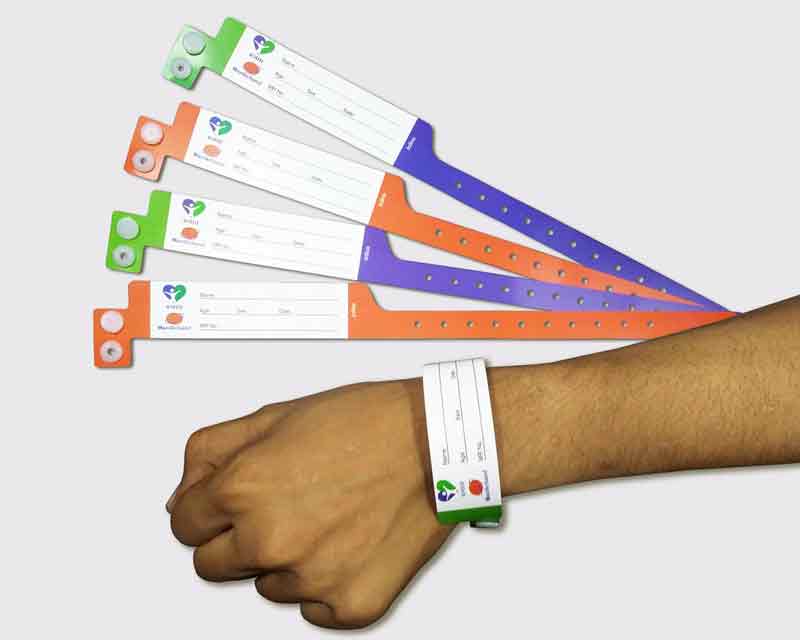The Evolution of the Patient Identification Band in Healthcare Settings
The Evolution of the Patient Identification Band in Healthcare Settings
Blog Article
Discovering the Various Types of Patient Identification Band Made Use Of in Medical Facilities
In the complex globe of healthcare, the important function of Patient Identification bands commonly goes unnoticed. These bands, differing from easy paper wristbands to advanced RFID bands, create the backbone of Patient safety and security procedures, ensuring precision in Patient Identification.
Understanding the Relevance of Patient Identification Bands
While they might appear like mere devices, Patient Identification bands play a vital function in medical facilities. These bands offer as an important tool for verifying Patient identification, stopping clinical mistakes related to misidentification. Patient Identification bands likewise help in improving administrative tasks, making certain exact record-keeping and payment.
Traditional Paper Wristbands: Their Use and Limitations
Conventional paper wristbands have actually been a staple in Patient Identification throughout different medical facilities. While their usage prevails, they harbor particular constraints that might influence their efficiency in Patient administration. This area will concentrate on the range of their application and the integral drawbacks connected with their use.
Paper Wristbands: Use Scope
In the realm of Patient Identification, paper wristbands have actually long held a critical role. These bands are typically utilized in outpatient setups, where the Patient's remain is short-term. Regardless of developments in technology, the modest paper wristband continues to be a reliable and cost-efficient service for Patient Identification in various medical care circumstances.
Limitations of Paper Wristbands
Despite their extensive use, paper wristbands are not without their drawbacks. In enhancement, paper wristbands often lack the technical abilities of more modern-day choices, such as barcoding or RFID chips, restricting their functionality to just presenting created details. Paper wristbands can cause discomfort or skin inflammation to some patients, particularly when put on for extensive durations.
Barcoded Wristbands: Advancements in Patient Identification
While Patient Identification has actually long been an important facet of medical care, the development of barcoded wristbands symbolizes a considerable jump ahead. These bands leverage the simplicity of barcoding technology, allowing for Patient info to be swiftly checked and accessed. They improve the speed and accuracy of Patient Identification, reducing the danger of clinical mistakes connected to misidentification. Barcoded wristbands are affordable, simple to create, and get rid of handwriting mistakes usual with hand-operated systems. Nonetheless, they are not without constraints. While they supply enhancements over traditional bands, the barcode can become smudged or used, rendering it unreadable. Regardless of this, barcoded wristbands continue to be a necessary tool in modern health care setups, symbolizing the intersection of technology and Patient care.
Superhigh Frequency Identification (RFID) Bands: an Action In The Direction Of Futuristic Healthcare
The development of Patient Identification bands has actually brought about the development of Superhigh frequency Identification (RFID) Bands (patient identification band). These innovative tools existing crucial benefits for medical care centers, offering a much more effective and technically advanced methods of Patient Identification. The implementation of RFID in medical care is a substantial step towards a much more advanced method to Patient management and safety and security
Comprehending RFID Bands

RFID Bands: Key Advantages
Largely, these bands improve Patient safety by giving exact, immediate Identification, consequently decreasing clinical errors. RFID bands can save a substantial quantity of Patient information, including medical history and allergies, allowing individualized care. On visit this website the whole, RFID bands represent a significant development in Patient Identification technology, benefiting both people and health care providers.
Executing RFID in Healthcare
These bands provide a smooth method to track and recognize patients, ensuring their security and enhancing efficiency in therapy procedures. RFID bands decrease medical errors by offering exact Patient Identification, which is vital in stopping misdiagnosis or incorrect medicine management. Thus, the execution of RFID bands is a significant action in the direction of boosting Patient security and medical care distribution.

Color-Coded Wristbands: Helping in Quick and Accurate Medical Diagnosis
In the dynamic atmosphere of a medical center, color-coded wristbands have arised as vital tools for swift and precise Identification of a client's medical condition. These wristbands, worn by clients, lug specific colors that correspond to various clinical problems or standings. This system is created to offer immediate visual hints to healthcare service providers, improving Patient safety and security and care quality.
Methods for Efficient Execution and Administration of Patient ID Bands
Accomplishing ideal use of Patient Identification bands demands a well-structured approach for their implementation and management. Patient education and learning is additionally important; clients must understand the function of the bands and the demand for their consistent wear. It's important to have a backup plan in area, such as visit here barcode scanning or biometrics, to ensure that Patient Identification is never endangered.
Verdict
Patient Identification bands are essential in medical facilities to make certain security and precision. Efficient execution and management of these bands can significantly decrease medical errors, increase efficiency, and boost total Patient treatment.
These bands, varying from straightforward paper wristbands to advanced RFID bands, develop the backbone of Patient safety protocols, making certain precision in Patient Identification.The advancement of Patient Identification bands has actually brought concerning the emergence of Radio Frequency Identification (RFID) Bands. Overall, RFID bands stand for a substantial advancement in Patient Identification technology, benefiting both people and healthcare companies.
RFID bands minimize medical errors by giving exact Patient Identification, which is essential in avoiding misdiagnosis or incorrect medicine management. Patient education is also crucial; individuals have to recognize the purpose of the bands and the need for their continuous wear.
Report this page